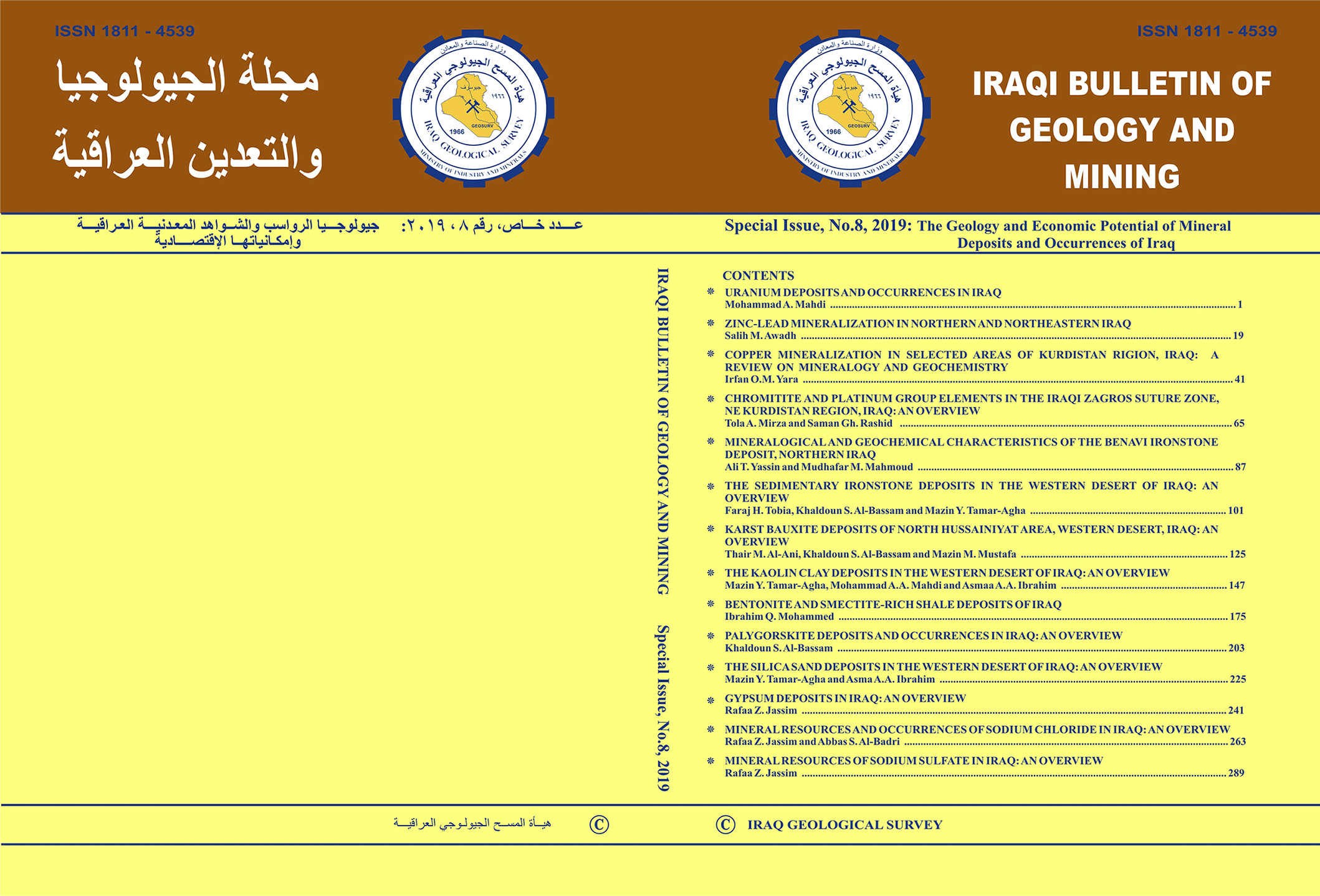Abstract
This is a review paper on the results of the extensive exploration for radioactive minerals in Iraq, based on previous reports and published papers. The radiometric, geological and geochemical surveys carried out by the Nuclear Geology Department in the Iraqi Atomic Energy Commission since 1966 and later continued by Iraq Geological Survey showed significant radioactivity related to uranium and partly to thorium in the Zagros Suture Zone, mostly related to acidic intrusions of igneous rocks (anorthosite) and associated metamorphic rocks (olivine marble). The Qalat Diza region is the most prominent in this part of Iraq. The Lower Miocene Euphrates Formation is found with remarkable radioactivity along the Hit – Abu Jir (Euphrates) Fault Zone and related to uranium hosted in carbonate rocks in the uppermost part of the formation. The most prominent in this region is Abu Skhair uraniferrous deposit. Numerous areas with anomalous radioactivity are found in the Western and Southern deserts related to Paleogene and Upper Cretaceous phosphorite exposures. Several theories have been postulated to explain the source of syngenetic uranium enrichment in the Euphrates Formation along the Euphrates River, but it is agreed that successive oxidizing and reducing conditions were effective in the epigenetic uranium concentration in these carbonate rocks. Detailed exploration in the Abu Skhair deposit led to the opening of an underground mine and to the development of an efficient uranium extraction process despite the poor grade of the deposit classified as a lean ore. The results obtained so far point to the absence of commercial uranium deposits in Iraq, but the potential of phosphorites, as uranium-bearing rocks, is very significant. Industrial experience at Al-Qaim fertilizers plant proved that uranium can be effectively and commercially extracted as a by-product during the production of phosphate fertilizers.
Keywords
Uranium; Thorium; Radiometric survey; Iraq
Abstract
هذه ورقة مراجعة علمية عن الاعمال المكثفة التي تمت في العراق للاستكشاف والتحري عن الخامات المعدنية المشعة تم اعدادها على ضوء المعلومات التي افرزتها الدراسات السابقة التي نفذت من قبل قسم الجيولوجيا النووية في منظمة الطاقة الذرية العراقية منذ عام 1966 واستكملت لاحقا من قبل هيأة المسح الجيولوجي العراقية. أشارت نتائج المسوحات السابقة الى وجود مناطق محدده في نطاق زاغروس الالتحامي مرتبطة في معظمها باندفاعات لصخور نارية حامضية مثل الانورثوسايت والصخور المتحولة المرافقة لها مثل المرمر الحامل للاولفين وتعتبر منطقة قلعة دزه من أهم هذه المناطق. تم رصد واستكشاف العديد من المناطق ذات الاشعاعية العالية المرتبطة باليورانيوم الموجود في صخور كاربونيتية في الجزء الأعلى من تكوين الفرات (المايوسين الأسفل) على طول نطاق فالق هيت – أبو الجير المحاذي لنهر الفرات ويعتبر راسب اليورانيوم في منطقة ابو صخير من أهمها. أثبتت التحريات والمسوحات الأرضية ارتباط معظم المناطق ذات الاشعاعية العالية في مناطق الصحراء الغربية والجنوبية برواسب الفوسفات المكشوفة على سطح الارض. تم تقديم عدة فرضيات لأصل وكيفية إغناء اليورانيوم المرافق للترسيب في تكوين الفرات غير ان هناك اتفاق ان هناك عمليات أكسده تعرضت لها الطبقة الحاملة لليورانيوم رافقها انسلاخ لليورانيوم الأولي ثم اعادة ترسيب في ظروف اختزالية سادت المكان وأدت الى إغناء ثانوي لليورانيوم عند سطح التماس العلوي للتكوين. أدت التحريات التفصيلية في راسب ابو صخير الى فتح منجم تحت سطحي وتطوير مسار تكنولوجي لاستخلاص اليورانيوم رغم تدني محتواه في الصخور. تشير النتائج المستحصلة لغاية الان الى احتمالية ضعيفة لوجود رواسب اقتصادية من اليورانيوم غير ان الصخور الفوسفاتية في الصحراء الغربية تمثل مصدرا مهما لليورانيوم في العراق حيث أثبتت العمليات الصناعية في مجمع القائم للأسمدة الفوسفاتية امكانية اسنخلاص اليورانيوم بطريقة فعالة واقتصادية كناتج عرضي أثناء عمليات تصنيع الأسمدة.
